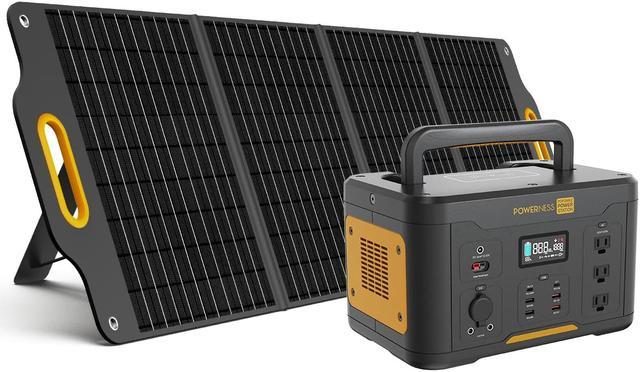Imagine being on a camping trip, off-grid, or facing a power outage, and still having access to a reliable power source for your electronic devices. Introducing Portable Power Station, a versatile and eco-friendly solution that can power your devices in various situations.
Table of Contents
Key Takeaways
Understanding Portable Power Stations requires an evaluation of factors such as input wattage, output wattage and battery capacity.
There are three types of portable power stations: solar-powered, battery-powered and hybrid.
Consider key features like capacity, charging outputs/inputs to find the right one for your needs. Maximize lifespan by following manufacturer instructions & proper storage practices.
Understanding Portable Power Stations

Portable power stations are large batteries housed in protective boxes, featuring AC outlets and other charging ports for various electronic devices, from phones and table fans to heavy-duty work lights and CPAP machines. Their versatility, ruggedness, and portability make them an ideal power source for camping trips, off-grid living experiences, or as an emergency power supply during power outages. The best portable power station for your needs depends on the devices you plan to power and the required watt-hours.
These power banks use advanced battery technology, such as lithium-ion (Li-Ion), NCM, or lithium-ion phosphate batteries (LiFePO4/LFP), which boast impressive power, fast charging, and a longer lifespan than traditional batteries. A careful evaluation of factors such as input wattage, output wattage, and battery capacity will guide you to the ideal portable power station tailored to your needs.
Types of Portable Power Stations

There are three main types of portable power stations: solar-powered, battery-powered, and hybrid, each with its own advantages and applications.
Solar-powered portable power stations, also known as solar generators, use solar panels for solar charging their batteries, providing a renewable and eco-friendly energy source.
Battery-powered portable power stations, also known as battery powered generators, rely on built-in batteries that can be charged via wall outlets, car sockets, or solar panels, offering flexibility and convenience.
Hybrid portable power stations combine the benefits of both solar and battery-powered options, providing versatile and efficient power solutions.
Solar-Powered Portable Power Stations
Solar-powered portable power stations utilize solar panels to charge their batteries, making them an eco-friendly and renewable energy option. These solar generators capture sunlight and transform it into usable power, offering an environmentally friendly substitute for traditional fossil fuel-powered generators.
Popular brands of solar-powered portable power stations include:
Goal Zero
Jackery
Renogy
Ecoflow
757 PowerHouse
These brands offer a variety of solar-powered generators, each with unique specifications and features to suit various applications. For instance, the Renogy portable solar generator is equipped with a solar battery, charge controller, and inverter and can be charged via solar panels, a wall outlet, or a 12v auto socket.
The selection of an optimal solar-powered portable power station is influenced by factors like required power output, charging efficiency, and portability. Some portable solar generators, like the BigBlue 28W USB Solar Charger, are specifically designed for USB charging while outdoors.
Battery-Powered Portable Power Stations
Battery-powered portable power stations are equipped with built-in batteries that can be charged via wall outlets, car sockets, or solar panels, providing flexibility and convenience. These power stations offer a wide range of charging options, including standard 120v outlets, USB ports, and DC chargers, which cater to a variety of electronic devices.
There is a multitude of battery-powered portable power stations on the market, each with unique features and specifications. For example, the Jackery Explorer 300 offers:
Lightweight and portable design
Lower power and capacity than larger models
Unable to run an air conditioner or charge multiple laptops
Can still run a tabletop fan for up to 6 hours
On the other hand, the EcoFlow Delta Pro is one of the largest portable power stations available, with a capacity of 3.6kWh (expandable up to 25kWh) and is also capable of fast charging.
In selecting a battery-powered portable power station, factors like capacity, charging outputs, and charging inputs must be taken into account to guarantee the power station aligns with your specific needs.
Hybrid Portable Power Stations
Hybrid portable power stations combine the benefits of both solar and battery-powered options, providing versatile and efficient power solutions. These power stations utilize solar panels for charging, as well as built-in batteries that can be charged via wall outlets or car sockets. As a result, they offer an adaptable and convenient source of power for various applications.
One notable hybrid portable power station is the EcoFlow Delta 1300, which boasts a battery capacity sufficient to power most devices, including laptops and CPAP machines, for an entire day or night. With a maximum output more than twice as high as the top pick from Jackery, this power station is suitable for more demanding power needs. However, it is important to consider factors such as weight and portability, as the EcoFlow Delta 1300 is approximately 9 pounds heavier than the top pick.
By carefully evaluating the features and specifications of hybrid portable power stations, you can choose the best option for your unique power requirements, whether you need a reliable power source for camping trips, off-grid living, or emergency backup power.
Key Features to Consider When Choosing a Portable Power Station
When selecting a portable power station, it is essential to consider the following factors:
Capacity: The power capacity of a portable power station determines the amount of charge stored in the battery, directly influencing the usage time and the capability to power larger devices.
Charging outputs: The charging outputs of a portable power station determine the types of devices that can be charged and the charging speed.
Charging inputs: The charging inputs dictate how the power station can be recharged.
Additional features: Consider additional features such as safety protections and portability.
By considering these factors, you can choose the portable power station that best suits your needs.
Additionally, it is crucial to consider the size and weight of the portable power station, as these factors affect portability and ease of transportation. Smaller, lighter units may be more suitable for camping trips and outdoor adventures, while larger, more powerful units may be better suited for off-grid living or emergency backup power.
Finally, safety features such as a battery management system, fire protection, and shock resistance should also be taken into account when choosing a portable power station. These features ensure the safe and efficient operation of the power station, protecting both the unit and the devices connected to it.
Learn more, visit Choosing the Right Portable Power Station: Factors to Consider.
Top Portable Power Station Brands
When it comes to portable power stations, several brands stand out for their quality and innovation. Renogy, Jackery, and EcoFlow are all well-regarded brands in the portable power station market.
Renogy offers a range of portable power stations, including:
LYCAN 5000 Power Box: continuous power output of 3500W and a peak power output of up to 7000W
Jackery Explorer 1000: rugged exterior, easy-to-use interface, and a maximum output of 1,370W
EcoFlow Delta Max 2000: 2,016Wh battery life, 6 AC outlets, 2 USB-C PD ports, 4 USB-A ports, and a pure sine-wave inverter.
By researching and comparing these top portable power station brands, you can find the perfect unit to meet your specific power needs, whether for camping, off-grid living, or emergency backup power.
How to Maximize Your Portable Power Station’s Lifespan
To maximize the lifespan of your portable power station, it is essential to consider factors such as maintenance, usage frequency, and battery type. Most portable power stations have a 500-cycle lifespan, and the type of battery used in the power station can significantly affect its lifespan. For instance, LiFePO4 batteries have a longer lifespan compared to lithium-ion batteries, with the capacity to withstand thousands of charge cycles.
Proper storage, handling, and charging practices can also ensure the safe and efficient operation of your portable power station. It is recommended to store the power station in a dry, cool environment, away from extreme heat, cold, and humidity, and elevated a few inches off the ground.
By adhering to the manufacturer’s instructions for maintenance and usage, and considering factors such as usage frequency, battery type, and quality of components, you can maximize the lifespan of your portable power station and enjoy a reliable power source for years to come.
Solar Panels and Portable Power Stations
Solar panels can be used to charge portable power stations, providing a renewable and eco-friendly energy source for various applications. To connect solar panels to a power station:
Locate the power station’s input jack marked ‘DC In’ or ‘Solar Input’.
Connect the solar panels to the input jack.
The solar panels will convert sunlight into DC electricity.
The DC electricity will charge the power station’s battery.
The following solar panels are popular for their portability, efficiency, and power output:
Bluetti PV350
BigBlue SolarPowa 28
Goal Zero Nomad 50
Jackery SolarSaga 100W
X-Dragon Monocrystalline
BioLite SolarPanel 5+ 2.0
Anker Solar Panel 625 100W
The duration of charging a power station with solar panels can vary depending on factors such as the capacity of the power station, the efficiency of the solar panels, and the amount of sunlight available.
It is possible to use a portable power station while being charged by a solar panel, allowing you to power your devices while the battery is being recharged. However, it is advised to avoid using the power station while charging if you want to optimize the lifespan of the batteries.
Safety Precautions and Usage Guidelines
Safety measures and usage guidelines for portable power stations entail appropriate storage, handling, and charging practices for secure and efficient operation. For optimal storage, it is recommended to:
Keep the power station in a dry and cool environment, away from extreme heat, cold, and humidity
Elevate the power station a few inches off the ground
Store the power station in an airtight container with a desiccant to keep it dry
Turn off the power station prior to storage
It is essential to protect your portable power station from extreme weather conditions that could affect its performance. Hot weather can decrease the runtime and output of the power station due to lower air density, while cold weather can reduce battery capacity and overall performance.
Furthermore, when utilizing a portable power station, safety features like a battery management system, fire protection, and shock resistance should also be considered. These features ensure the safe and efficient operation of the power station, protecting both the unit and the devices connected to it.
Comparing Portable Power Stations and Traditional Generators
Portable power stations hold several benefits over traditional generators, including quieter operation, eco-friendliness, and simpler maintenance. While traditional generators produce power through the combustion of fossil fuels, portable power stations store energy within their batteries, providing a clean and silent power source. This makes them suitable for use both indoors and during nighttime hours without disturbing the peace.
In terms of environmental impact, traditional generators emit pollutants such as toxic gases, which can be harmful to humans, animals, and plants, as well as contributing to air and noise pollution. In contrast, portable power stations, especially those using renewable energy sources like solar or wind, have a lower environmental impact as they do not produce hazardous emissions or noise pollution.
Additionally, portable power stations offer several advantages over traditional generators:
They are more compact and lightweight, making them easier to transport and store.
They provide a versatile power solution for various applications.
They offer multiple charging options, including solar panels, wall outlets, and car sockets.
These features make portable power stations a convenient and efficient choice for powering your devices.
Portable Power Stations for Various Applications
Portable power stations can be used for a variety of applications, such as camping and outdoor adventures, off-grid living, and emergency backup power. With their versatility, portability, and eco-friendly power sources, portable power stations are an invaluable tool for those who require a reliable power source in various situations.
Camping and Outdoor Adventures
Portable power stations offer a handy and dependable power source for charging devices and running small appliances during camping and outdoor adventures. These power stations are lightweight and easy to transport, making them ideal for use in remote locations or during outdoor activities like:
Camping
Hiking
Fishing
RVing
Tailgating
Beach trips
In comparison to other portable power stations, these models provide a reliable and convenient solution for your portable power needs.
With a portable power station, you can keep your devices charged and have access to electricity wherever you go.
Portable power stations can power a variety of devices commonly used in camping and outdoor activities, such as:
Lighting
Smartphones
Laptops
Fans
Camping equipment
To determine the power requirements of each device, it is essential to consult the wattage or amperage specifications and consider the total power requirement for all devices used concurrently.
Some popular portable power stations for camping and outdoor adventures include the Jackery Explorer 1000, Pecron E2000LFP, and BioLite BaseCharge 1500. By researching and comparing these power stations, outdoor enthusiasts can find the best portable power stations to meet their power needs during camping trips and outdoor excursions.
Off-Grid Living
Portable power stations serve as a sustainable and reliable energy source for powering essential appliances and devices, proving beneficial for off-grid living. In off-grid settings, access to traditional power sources may be limited or unavailable, making portable power stations an invaluable resource for maintaining a comfortable and functional living space.
Portable power stations can power major household appliances, such as refrigerators, freezers, and washing machines, as well as smaller devices like laptops, smartphones, lights, and fans. By evaluating your energy usage and factoring in the number of solar panels and battery storage capacity needed, you can ensure an adequate power supply for off-grid living.
Notable portable power stations for off-grid living include the Jackery Explorer 1000, EcoFlow Delta, and Goal Zero Yeti series, each designed to provide reliable power for a range of appliances and devices. By comparing these power stations, individuals living off-grid can find the ideal power solution to meet their energy needs.
Emergency Backup Power
Portable power stations play a vital role in providing emergency backup power, offering a reliable power source during power outages and natural disasters. In times of crisis, access to electricity can be a lifesaver, enabling individuals to maintain essential devices and appliances such as lighting, communication devices, and medical equipment.
Portable power stations like the Renogy LYCAN 5000 Power Box, with a continuous power output of 3500W and a peak power output of up to 7000W, can provide reliable power during emergencies. Additionally, the EcoFlow Delta 1300 has a battery capacity sufficient to power most devices, including laptops and CPAP machines, for an entire day or night.
By investing in a portable power station for emergency backup power, you can ensure a reliable power source is available during power outages and natural disasters. This can provide peace of mind and help maintain essential services during a crisis.
Summary
In conclusion, portable power stations offer a versatile, eco-friendly, and reliable power solution for various applications such as camping and outdoor adventures, off-grid living, and emergency backup power. By understanding their features, considering key factors such as capacity, charging outputs, and battery type, and comparing top brands and models, you can find the perfect portable power station to meet your specific needs. Invest in a portable power station today and experience the convenience, reliability, and peace of mind that comes with always having power at your fingertips.
Frequently Asked Questions
Is it worth buying a portable power station?
A portable power station is an excellent investment as it provides reliable off-grid electricity, incurs no extra expenses, and ultimately saves money due to its long-term use.
How long will a portable power station run?
A 200W portable power station with a 500Wh capacity can run devices that consume 200W for approximately 2.5 hours, while lower-wattage teams can provide around 10 hours of emergency power and higher-wattage units can offer several days of power. Many systems also allow for solar panel charging, providing continuous charging options during extended outages.
What is the difference between a power bank and a portable power station?
Power banks are typically more portable and lightweight than power stations, making them ideal for travel. However, power stations have a higher output, enabling them to run a wider range of electronics, such as a refrigerator or projector.
What devices can be powered by portable power stations?
Portable power stations can be used to power a variety of electronic devices, including smartphones, laptops, and larger appliances.
How long does it take to charge a portable power station using solar panels?
It typically takes 1.5 to 48 hours to charge a portable power station using solar panels, depending on the capacity of the power station, the efficiency of the solar panels, and the amount of sunlight available.









